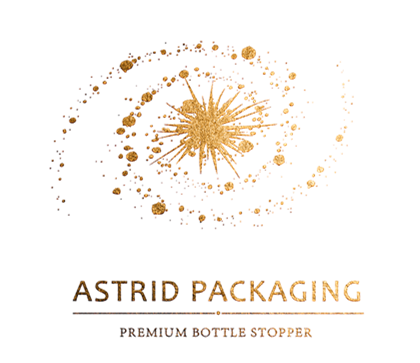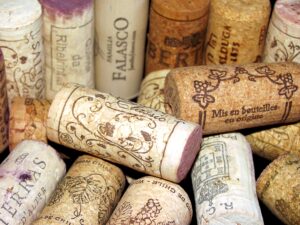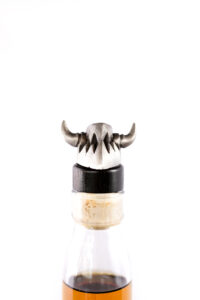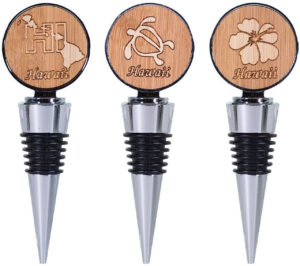Wine has been enjoyed for thousands of years, and over time, many different methods have been developed to enhance the drinking experience. One such method is the use of customized wine bottle caps. These caps, which can be personalized with logos, text, or images, have become a popular way to add a unique touch to wine bottles for special events, gifts, or even as a marketing tool for wineries. But where did the idea for customized wine bottle caps come from? Let’s take a look at the history of this fascinating practice.
What customized wine bottle caps are?

Customized wine bottle caps are decorative or functional elements placed on the top of wine bottles. They can be made of various materials such as plastic, cork, or metal, and are typically designed to fit the size and shape of the bottle’s neck.
These caps serve a practical purpose by protecting the wine from oxidation and contamination. They also help to maintain the wine’s quality and flavor by preventing air from entering the bottle.
However, customized wine bottle caps are not just a functional element of wine packaging. They are also an essential part of building a brand identity. Wineries and wine producers use customized bottle caps as a way to differentiate their products and make them stand out on store shelves. These caps can be personalized with the winery’s logo, artwork, or other design elements that help to create a unique and recognizable brand image.
In addition, customized wine bottle caps are also popular for special events such as weddings, corporate events, or other celebrations. They can be personalized with the event’s name, date, or other details, making them a memorable keepsake for guests.
Overall, customized wine bottle caps are an important part of wine packaging and branding. They serve a practical purpose while also helping to build a distinctive brand image and make wine bottles stand out on store shelves.
The earliest forms of wine bottle caps

The earliest form of wine bottle cap was the cork stopper, which dates back to ancient Greece and Rome. Cork stoppers were made from the bark of cork oak trees and were used to seal wine bottles, preventing air from entering and wine from spoiling.
Cork stoppers were widely used throughout Europe by the 17th century, but they had some drawbacks. For example, they were often of uneven quality, leading to inconsistencies in the seal and oxidation of the wine. Additionally, cork stoppers were prone to developing a musty odor over time, which could affect the wine’s flavor.
To combat these issues, wine producers began experimenting with different materials and methods for sealing wine bottles. One popular method was to use wax seals, which were applied over the cork stopper to provide an additional layer of protection against air and contamination.
Wax seals were particularly popular in the 18th and 19th centuries, and were often used for high-end wines and special occasions. They were made by melting wax and pouring it over the cork stopper, then stamping the wax with a seal to identify the wine’s producer or to indicate its quality.
In the 20th century, advances in technology led to the development of new materials for wine bottle caps, such as plastic and metal screw caps. These materials provided a more consistent seal than cork and were less prone to oxidation and spoilage. However, cork stoppers and wax seals continue to be used today, particularly for high-end wines that are intended for long-term aging.
Overall, the history of wine bottle caps is one of evolution and experimentation. From cork stoppers to wax seals and beyond, wine producers have continuously sought out new and better ways to protect their products and create a distinctive brand image.
The more modern designs for customized wine bottle caps



In recent years, new materials and designs for wine bottle caps have emerged, offering both practical and aesthetic benefits. Here are some examples of modern designs for customized wine bottle caps:
Screw caps: These are made of metal or plastic and are designed to screw onto the neck of the wine bottle. They are easy to use, provide a consistent seal, and are less prone to spoilage than cork stoppers. However, some people argue that screw caps are not as aesthetically pleasing as cork stoppers and may not be suitable for high-end wines.
Synthetic corks: These are made of materials such as plastic or silicone and are designed to mimic the look and feel of natural cork. They offer a consistent seal and are less prone to spoilage than cork stoppers. However, some people argue that synthetic corks don’t allow for as much oxygen exchange as natural cork, which can affect the wine’s aging process.
Glass stoppers: These are made of glass and are designed to fit into the neck of the wine bottle. They provide an airtight seal and are visually striking, making them a popular choice for high-end wines. However, glass stoppers are relatively expensive and may not be suitable for wines that are intended for long-term aging.
Customized metal caps: These are made of metal and can be personalized with logos, artwork, or other design elements. They are visually striking and can help to create a distinctive brand image. However, they may not be suitable for wines that are intended for long-term aging, as metal can interact with the wine and affect its flavor.
Overall, modern designs for customized wine bottle caps offer a range of benefits and drawbacks. They have impacted the wine industry by providing new options for wine packaging and branding, but they also raise questions about the impact of these materials on wine quality and aging. As the industry continues to evolve, it will be interesting to see what new designs and materials emerge for wine bottle caps.
The future of customized wine bottle caps
The future of customized wine bottle caps is exciting and full of possibilities. As the wine industry continues to evolve, it’s likely that we’ll see even more personalized and unique designs for bottle caps. Here are some trends that may emerge in the coming years:
Sustainable materials: With increasing attention on environmental sustainability, it’s possible that we’ll see more wine bottle caps made from eco-friendly materials such as recycled plastic or plant-based materials.
Smart caps: As technology advances, it’s possible that we’ll see “smart” wine bottle caps that can provide information about the wine’s origin, aging process, or flavor profile. This could be a useful tool for consumers and could also help wine producers to differentiate their products.
Augmented reality: With the rise of augmented reality technology, it’s possible that wine bottle caps could be designed to interact with smartphones or other devices, offering a unique and immersive experience for consumers.
Customized shapes: While most wine bottle caps are currently designed to fit the standard wine bottle neck, it’s possible that we’ll see more customized shapes and sizes in the future. This could allow wine producers to create unique and eye-catching designs that stand out on store shelves.
Overall, the future of customized wine bottle caps is exciting and full of potential. Whether it’s through new materials, innovative designs, or technological advancements, wine producers will continue to find new ways to enhance the wine drinking experience and build brand identity through customized bottle caps.
In conclusion, the use of customized wine bottle caps has a rich and interesting history dating back centuries. From sealing wax to modern-day customizable options, these caps have evolved alongside the wine industry itself. As consumers become more discerning and demand more personalized experiences, it’s likely that customized wine bottle caps will continue to be an important part of the industry for years to come. Whether it’s to promote a brand or simply add a touch of elegance, these caps offer a unique and memorable way to elevate any bottle of wine.





